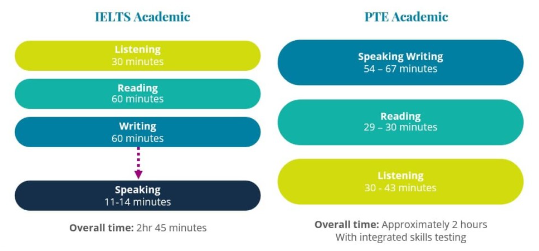PTE versus IELTS – Introduction
The best part about the 21st century is the broadening of the horizons to pursue education or higher education out of India. With globalisation kicking in, the avenues to study abroad also increased magnanimously. This led to many standardised tests for English-speaking countries
Amongst these tests, the most popular are the PTE (Pearson Test of English) and IELTS (International English Language Testing System), which happen to be the most common choices of standardised tests to migrate, study or work abroad.

Image source: Pearson PTE
PTE – Overview
PTE, conducted by Pearson PLC, majorly relies on artificial intelligence (AI) based scoring system, because of which the process is unbiased and free from human prejudice, and also fast. The PTE is a tri-partite test comprising the following fragments – speaking and writing (together), listening, and reading.
If you take a PTE test for yourself, you will be scored on a scale of 10 to 90 points for both communicative skills (as mentioned above) and enabling skills. In addition, the overall score is also measured on a scale of 10 to 90 points.
IELTS – Overview
British Council, UK, the authority that conducts IELTS, has a renowned base of candidates, reviewers and assessors, that is responsible for manually evaluating the scores of applicants’ submissions.
The average overall band score, which is 0 to 9, is also the average of the scores allotted under the four parts of the test, which include listening, reading, writing, and speaking. A point worth noting, however, is that the scoring under IELTS is prone to human errors because of human-conducted manual evaluation.
What to choose? What to take?
Before we jump to analysing the specific details of both tests as we shared with you above, it is worth mentioning that the PTE results come out within five days and IELTS results take around 2 weeks. This means, PTE gives you faster, more accurate and advanced results, well-furnished with technological processes.
However, it is a well-known and well-established fact that the IELTS is a renowned and world-wide accepted test by different prestigious universities and institutions across many countries. That way, it is advisable that you can take both tests because they have different prospects that make them attractive individually, since they are both priced identically for registration purposes.
Criteria – Tick your boxes
The best way to make a choice at a higher level is to make multiple choices at the lower levels. We lay down a few criteria with differences to pick your choice and then choose your pick to go forward!
- Ease of Difficulty – Since both the tests are fragmented into similar sections of listening, reading and writing, and speaking, the choice can be made between whether you want to take up 3 sections (PTE) or 4 sections (IELTS).
- Mode of Speaking Test – PTE entails an online speaking test wherein one has to speak into the microphone to be assessed at a later stage in a computerised format. IELTS on the other hand, has a face-to-face interaction for the speaking test.
- Evaluation Mechanism – In PTE, the scoring and evaluation is based on artificial intelligence with negligible human interference and bias. In IELTS, the old-fashioned way of human-oriented evaluation is relied upon, thus prone to premonitions.
- Popularity and Acceptance – The PTE is not as popular as IELTS, when it comes to world-wide acceptance by institutions. It is IELTS that has a larger fan-base but again, is not everyone’s cup of tea.
- Immigration – The IELTS scores are considered for immigration applications but the PTE scores are generally not considered and welcomed.



